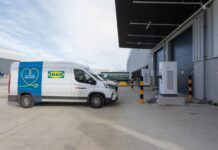Much has been documented about the death of the high street and irrevocable ecommerce trends rendering stores obsolete. But might physical stores see something of a comeback once restrictions are lifted?
On the one hand, online penetration will inevitably remain higher than it was pre-Covid. Indeed, John Roberts, CEO of AO World, recently said that he believed the shift to online shopping was a permanent one. If further proof were needed, Tesco’s recent financial results show the impact Covid has had on its ecommerce sales, with its online sales doubling to 15%. And perhaps the clearest manifestation of the demise physical retailing in its current form was the way online pure play giants, Boohoo and Asos, bought up the Arcadia and Debenhams brands following their collapse, but without the physical real estate.

However, in parallel to the ecommerce boom, the pandemic has also led to the emergence of hyper-local consumerism and a new lease of life for neighbourhood high streets. Forced to spend months on end at home, it has recalibrated people’s relationships with their local areas and stores. Many people have fallen back in love with their communities and wish to support local shops and brands.
With many employers pledging to adopt flexible and hybrid working models, consumers will continue spending time in their communities, and this will undoubtedly extend the local shopping trend into the foreseeable future.
🏆
The 2024 Creative Retail Awards are open for entries.
The Creative Retail Awards are much more than a mere accolade; they represent the pinnacle of achievement in the retail industry. Garnering a nomination or winning one of these awards is a testament to innovation, excellence, and leadership.
www.creativeretailawards.com
Already, we are seeing a number of brands thinking about how they can best serve neighbourhoods and communities. Many are rebalancing their store estates and expanding their presence in suburban areas through opening smaller stores, launching partnerships with retailers that already have a strong footprint in local areas and through creating new click-and-collect hubs.
How local high streets and ecommerce can co-exist
These developments will breathe life back into local high streets, but with a greater fusion between online and physical retail. The smaller format stores complement the ecommerce model and by showcasing key ranges with the aim of driving online purchases at a later date. Retailers are also cognisant that to be successful in local areas they have to place their stores at the heart of their communities and offer experiences that are more than just transactional. We are likely to see these stores, in addition to supporting the online offering, act as event spaces and hubs for local activity.
Perhaps the most notable retailer undergoing this shift is John Lewis. The brand is seeking to reshape its estate by slashing its large department stores and has plans to roll-out hundreds of concessions inside Waitrose supermarkets as well as and new Metro-style stores in high streets close to where its customers live. These stores will act primarily as showrooms, where shoppers can see products, interact with staff and order items for home delivery.
A number of such formats already exist in America and are highly successful. Neighbourhood Goods, which was founded in Texas in 2017, operates three stores and views a locally focused range of brands and experiences as its USP. Their stores have an ever-changing rotation of local brands stocked to drive repeat visits and engagement.
Stores in local high streets will also play an important role to fulfil online orders. Many retailers are turning their store networks into hubs that service click-and-collect and home delivery purchases. In this fiercely competitive retail environment, where speed is key, having stores that are in large population centres and can service orders quickly will be vital to establishing an advantage over competitors.
The moves will also see new partnerships emerging between retailers. To reach customers where they don’t have a store footprint, brands are partnering with others that do, to offer their sites as click-and-collect centres. For example, Next announced before Christmas that it had partnered with Morrisons to trial new collect and return ‘pods’ in two supermarket car parks, while John Lewis has partnered with Co-op to offer its shops as click-and-collect centres for its products across the UK.
The end of lockdowns, if all goes to plan, will be an exciting time for everyone, but particularly for the retail sector. The pandemic looks to have permanently altered living and shopping patterns in a new hyper-convenient, digital-first world. However, predictions of the permanent eradication of the high street are wide of the mark: there will always be a role for physical retailing, but it must evolve to be a more complementary bedfellow for the ecommerce world.














